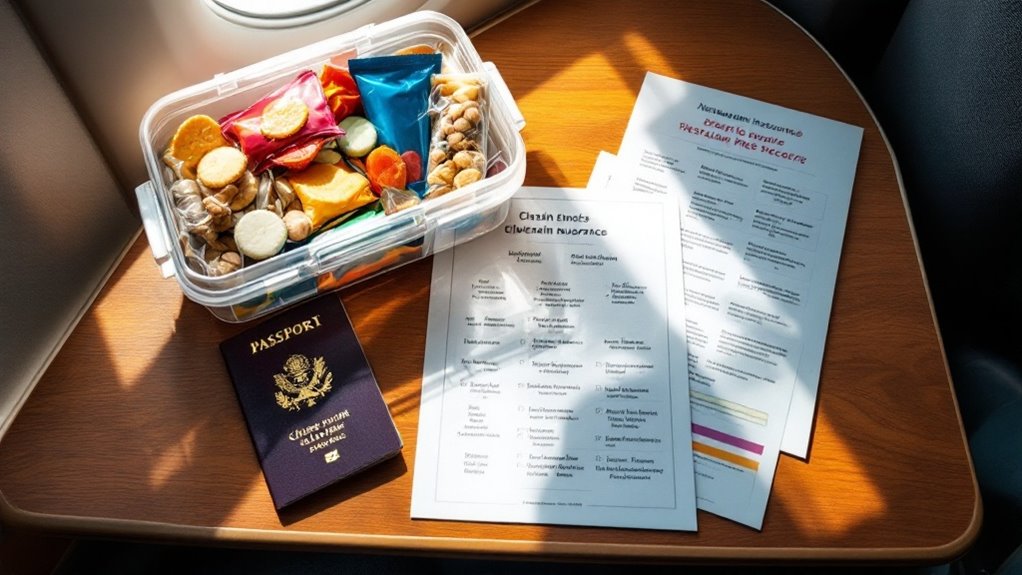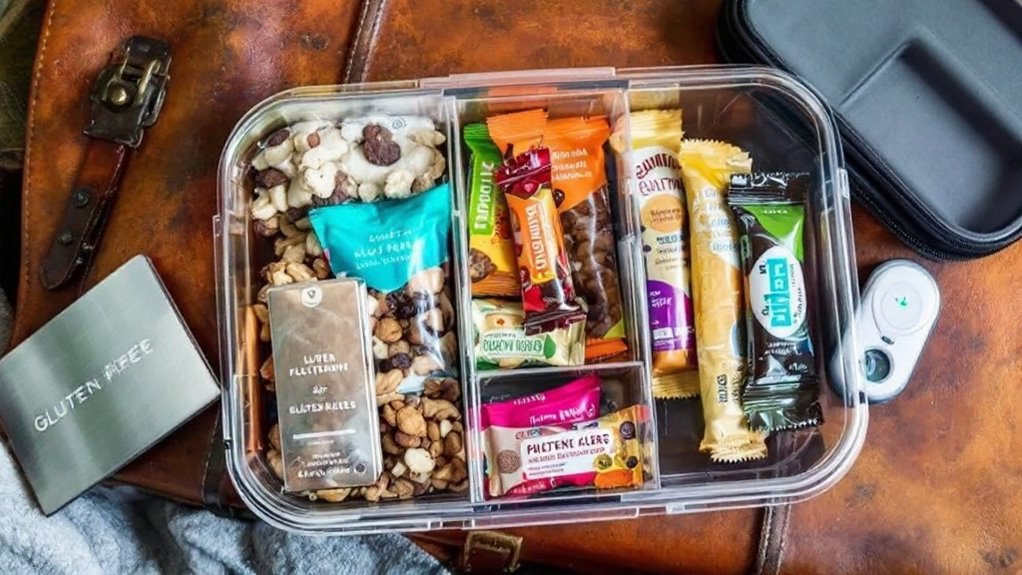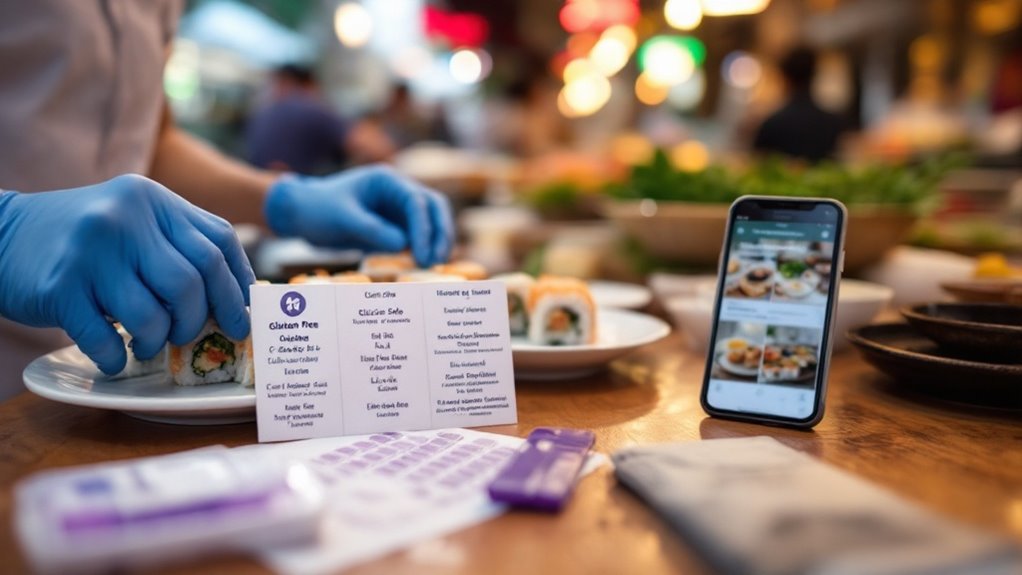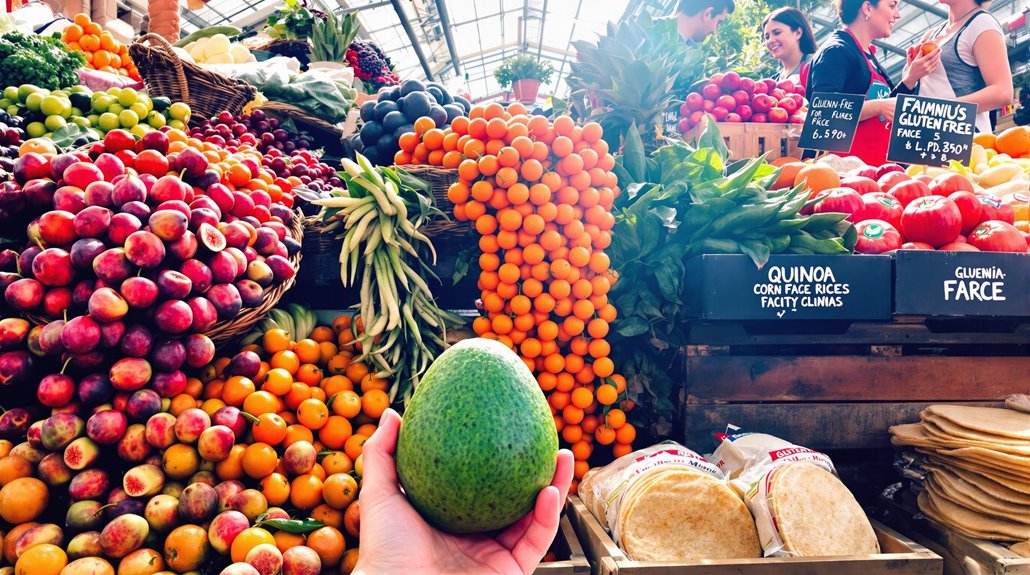Planning ahead is your best friend for gluten-free travel abroad. You’ll want to research safe restaurants using apps and websites, pack emergency snacks, and learn key phrases to communicate your dietary needs. Carry translation cards explaining gluten-free requirements, and stick to naturally gluten-free local dishes when possible. Book accommodations with kitchen access, and always watch for cross-contamination in shared spaces. There’s plenty more to discover about staying healthy on your global adventures.
Key Points
- Research and save gluten-free restaurants in advance using dedicated apps, websites, and local Celiac associations in your destination country.
- Carry translated restaurant cards explaining your dietary needs and learn basic phrases to communicate gluten-free requirements effectively.
- Pack emergency gluten-free snacks and consider booking accommodations with kitchen facilities for meal preparation control.
- Focus on naturally gluten-free local dishes and fresh ingredients from markets to minimize cross-contamination risks.
- Request special meals when booking flights and contact hotels beforehand to confirm gluten-free dining options.
Essential Pre-Trip Planning for Gluten-Free Travelers

Planning ahead is essential when traveling abroad with gluten sensitivities. You’ll want to start by researching gluten-free restaurants in your destination using websites, blogs, and apps. Save these locations on Google Maps for quick access during your trip.
Learn about the local cuisine to identify naturally gluten-free dishes made with ingredients like rice, corn, and vegetables. Having key local phrases ready will help you communicate your dietary needs effectively. Don’t hesitate to reach out to local celiac associations and food bloggers – they’re often happy to share their favorite spots and insider tips. Consider packing non-perishable backup food like protein bars and dried fruits for emergencies.
Create a list of universally safe foods like fruits, nuts, and cheese that you can find almost anywhere.
You’ll also want to double-check your accommodation options. Look for hotels with refrigerators or consider booking places with kitchens so you can prepare your own meals when needed.
When you’re dining abroad with gluten restrictions, finding safe restaurant options can feel like solving a puzzle. Your best bet is to seek out dedicated gluten-free establishments using apps like Find Me Gluten-Free or recommendations from local Celiac Disease Associations. In Italy, the AIC app proved invaluable for locating certified gluten-free restaurants.
Learn to spot naturally gluten-free options in local cuisines, like rice dishes in Asia or corn-based meals in Latin America. In cities like New York, you can find dedicated gluten-free bakeries offering everything from pastries to bagels.
You’ll want to carry language cards that explain your dietary needs, and don’t hesitate to double-check ingredients with restaurant staff. Watch out for hidden gluten in sauces and condiments, especially soy sauce.
Keep some gluten-free snacks handy for emergencies, and bookmark safe restaurants on your phone’s map app.
When in doubt, stick to fresh, local ingredients and naturally gluten-free foods like fruits, vegetables, and nuts.
Smart Packing Strategies for Gluten-Free Safety

Successfully traversing foreign restaurants sets the stage for your culinary adventures, but smart packing makes all the difference in maintaining a gluten-free diet abroad.
Pack your essentials in easy-to-carry portions: gluten-free bread, crackers, and a few favorite baked goods in sealed bags. Don’t forget toaster bags to prevent cross-contamination in shared toasters. Consider booking self-catering accommodation to have full control over your meal preparation and ingredients. Using packing cubes helps keep your gluten-free items organized and easily accessible in your luggage.
Stock up on non-perishable lifesavers like protein bars, nuts, and dried fruits for unexpected hunger strikes. You’ll want to bring gluten-free soy sauce packets and almond butter for added flavor options.
Keep perishables fresh in a small cooler with ice packs, and store dry goods in protective containers. Remember to pack your doctor’s note – it’ll help you breeze through security with your medical foods and give you peace of mind during your travels.
Finding Safe Accommodations and Transportation
Although traveling with dietary restrictions can feel intimidating, finding safe accommodations and transportation doesn’t have to be a headache. Start by researching hotels and resorts with gluten-free certifications, and don’t hesitate to call ahead to discuss your dietary needs. Worldwide hotel chains like Tui Blue Resorts offer extensive gluten-free options at their global locations.
When booking flights, request gluten-free meals in advance and reconfirm during check-in. Train travel requires extra caution since dining cars may not accommodate special dietary needs. For car trips, pack your own gluten-free snacks in a cooler.
If you’re taking a cruise, contact the line beforehand to understand their cross-contamination prevention procedures.
To guarantee a smooth stay, look up local celiac organizations at your destination and identify nearby gluten-free restaurants.
Consider using specialty travel companies that cater to gluten-free needs, and download helpful apps that can locate safe dining options.
Don’t forget to carry gluten-free language cards for clear communication abroad.
Managing Cross-Contamination Risks Abroad

Managing cross-contamination risks takes on new challenges once you’re away from your familiar kitchen setup. When you’re sharing kitchen spaces abroad, you’ll need to be extra vigilant about surfaces and utensils that might harbor gluten particles.
Don’t use communal toasters, cutting boards, or cooking pans that have touched gluten-containing foods. Clean hands thoroughly before handling any gluten-free ingredients to prevent contamination. Be wary of airborne flour in bakeries or shared kitchens, as these particles can settle on your gluten-free foods. Consider presenting gluten-free restaurant cards to kitchen staff to ensure they understand your dietary needs.
Skip bulk bins and buffets where shared scoops could introduce cross-contamination. Instead, bring your own cooking supplies, including sponges and utensils, when staying in shared accommodations.
When possible, prepare your own meals using fresh ingredients from local markets – it’s the safest way to control what goes into your food.
The Last Word
Traveling gluten-free doesn’t have to put a damper on your wanderlust. With careful planning, you’ll dance through foreign markets and dine like a local while keeping your tummy happy. Remember, you’re not limited – you’re just choosing a different path to food adventure! Pack those translation cards, keep your emergency snacks handy, and you’ll be all set to explore the world on your own delicious terms.

